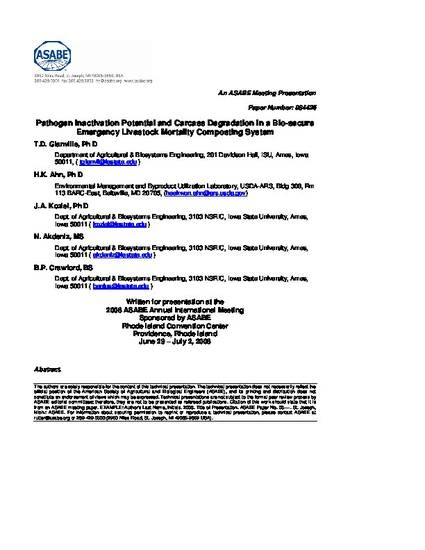
An emergency swine mortality composting study at Iowa State University was conducted to evaluate the performance of six on-farm carbon source or “envelope” materials (corn silage, oat straw, cornstalks, wood shavings, soybean straw, and alfalfa hay) when used in a plastic-wrapped passively-ventilated emergency composting system that was first employed for emergency disposal of poultry in British Columbia in 2004. With the exception of tub grinding to reduce the particle size of long and fibrous materials, they were used “as is,” in their normal state — as would likely be the case during an emergency — without benefit of mixing or preconditioning to optimize C:N ratios or moisture content. Moisture content fell into two distinct groups: wood, soy, and alfalfa products had initial moisture content of < 20%; while the other materials ranged from 55-62%. After 8 weeks moisture ranged from 11-18% and 27-35% respectively for the two groups. Minimum O 2 concentrations occurred during the first 2 weeks of composting, and ranged from 9-16% in relatively fine-grained wood and silage materials, to 17-20% in the others. Daily temperatures in material surrounding the carcasses also were highest during the first two weeks. Mean temperature ranges during the initial 30 days of composting were 47-57 °C for the moist group, and 35-43 °C for the dry group. Total soft-tissue degradation ranged from 77-78% for silage, wood shavings, and alfalfa hay, and from 85-88% for the other three materials. The highest degradation occurred in two materials having high initial moisture, and high mean 30-day temperatures, while the lowest degradation occurred in two materials having low 30-day mean temperatures and low initial moisture. The temperature/moisture correlation was not consistent, however, as soy straw — exhibiting both low mean temperature and low initial moisture — had high carcass degradation, and silage — having high temperature and high moisture — was in the group producing lower degradation. Remains recovered from all test units after 8 weeks appeared to be desiccated, suggesting that carcass decomposition was terminated by low moisture. This is consistent with the low final moisture levels, and indicates that moisture coming from the carcasses plays a significant role in sustaining decomposition. It also suggests that airflow rates through the matrix may have been excessive and that measures need to be taken to reduce airflow and prevent excessive moisture loss. Success rates meeting USEPA Class A or B criteria for pathogen reduction were much higher for the moist materials than for dry ones, indicating that procedures for emergency composting of carcasses resulting from disease should include pre-moistening of carcass surfaces and envelope materials, and to taking measures to control excessive airflow through the composting matrix that can result in premature drying of envelope materials.
Available at: http://works.bepress.com/thomas_glanville/26/

This is an ASABE Meeting Presentation, Paper No. 084426.